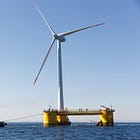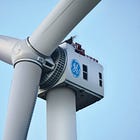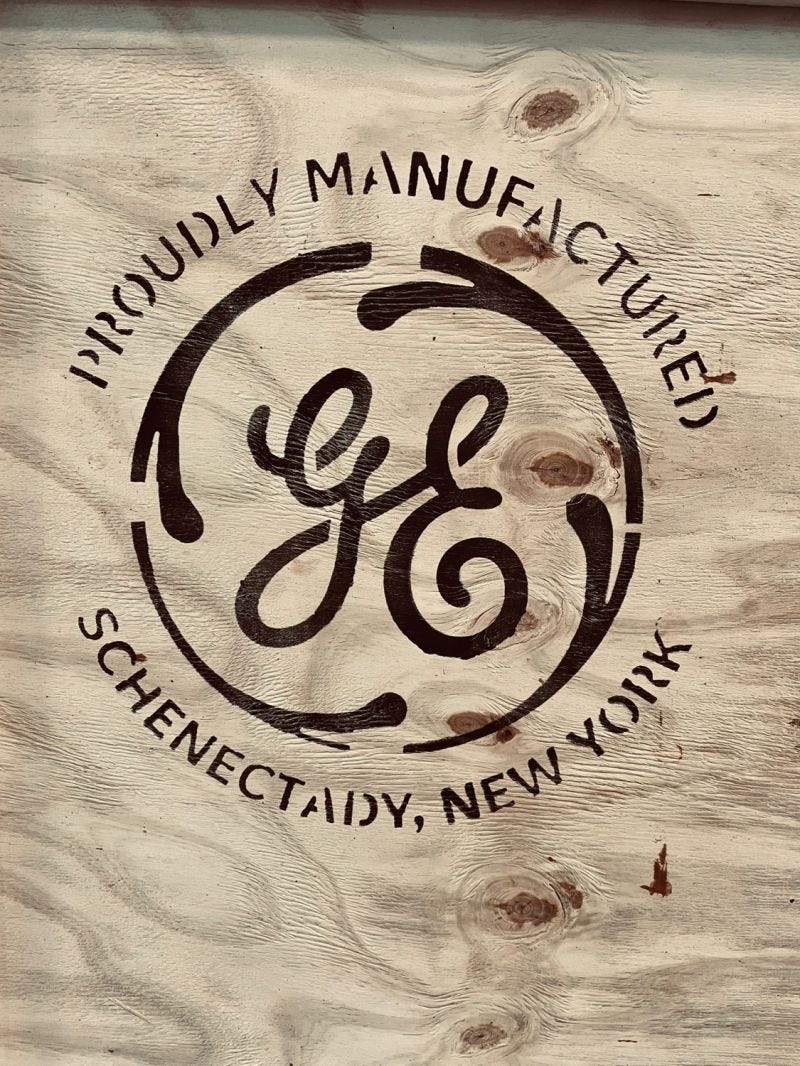Windletter #80 - Life cycle analysis of a wind turbine
Also: floating wind power at 86 €/MWh, Sany wins its first contract in India, Siemens Gamesa changes CEO, and more.
Hello everyone and welcome to a new issue of Windletter. I'm Sergio Fernández Munguía (@Sergio_FerMun) and here we discuss the latest news in the wind power sector from a different perspective. If you enjoy the newsletter and are not subscribed, you can do so here.
Windletter is sponsored by:
🔹 Tetrace. Specialized services in operation and maintenance, engineering, supervision, inspection, technical assistance, and distribution of spare parts in the wind sector. More information here.
🔹 RenerCycle. Development and commercialization of solutions and specialized services in the circular economy for renewable energies, including comprehensive dismantling of wind farms and waste management, refurbishment and sale of components and wind turbines, management and recycling of blades and others. More information here.
Windletter está disponible en español aquí
The most read from the latest edition has been: the video climbing a SWT-7.0-154 in Hornsea One, floating wind power may not be as easy as it seems, the GE Vernova repair and refurbishment workshop.
And now let's move on to the news of the week in an edition with a round number, issue #80.
♻️ Life Cycle Analysis: How much CO2 does the manufacturing of a wind turbine emit?
One of the most widespread myths about renewable energies in general, and wind power in particular, has always been the emissions associated with the manufacturing and construction of installations.
Also, the Energy Return on Investment (EROI), the ratio between the amount of energy a plant can produce during its lifespan and the amount of energy required to build and operate it, has been a subject of discussion.
These myths were especially prevalent in the early days of modern renewables and perhaps more commonly used against solar energy than wind energy. It is also true that over time they have been diluted by evidence.
However, it's never a bad idea to revisit some of these concepts, especially when manufacturers put so much effort into detailing and making public the so-called Life Cycle Analysis (LCA).
Recently, Vestas has published the LCA for its V236-15 MW wind turbine, which has orders (including signed, conditional, and preferred) worth more than 14 GW in the coming years.
And the truth is that the figures are remarkable:
It takes 13 months to generate all the energy invested in the manufacturing of the turbine and the construction of the wind farm.
The Energy Return on Investment is 27.
In the following picture, you can see the main data from the LCA.
The calculation is carried out for a representative wind farm (you can see the considerations in the table above) and also addresses other issues such as recyclability, toxicity, hazardous waste, water pollution...
It's really worth taking a look at the full report (be aware, it's 124 pages long), which in Vestas' case is particularly detailed. If only other industries had LCAs with this level of detail.
For the most curious, I'll leave links to reports from other manufacturers and other turbine models (although they are not always easy to find):
_
🌬️ BayWa r.e. and Elicio, winners of the French floating wind auction
The main topic of the last edition was the French floating wind auction and the statements of the French Minister of Economy, Bruno Le Maire, who mentioned a price below €100/MWh, which surprised many.
It was this week when the winners and the award price were revealed. The winner was a consortium formed by BayWa r.e. and Elicio with an award price of €86.45/MWh, exceeding all expectations.
Finally, the awarded megawatts amounted to 270, as the auction allowed a figure between 230 and 270. A total of 10 participants were bidding to secure the megawatts, giving us an idea of the interest shown.
The thing is, the €86.45/MWh has pleased many and frightened many others. I really can't assess well whether this price is dangerously low or not, as it requires knowing the auction details very well, which greatly affects the business case.
But undoubtedly, it seems an aggressive price and the sector is between expectant and surprised (interesting the comments section of this LinkedIn post or this thread on Twitter/X).
This award is a significant milestone for European offshore wind energy, as until now only pilot and demonstration projects had been developed. Several times we have discussed here about Kincardine and Hywind Scotland in the UK (30 MW each), WindFloat Atlantic in Portugal (25 MW), and Hywind Tampen in Norway (95 MW).
It is expected that France will announce the winners of another two 250 MW sites in the Mediterranean in December of this year. Meanwhile, the next European markets where there should be movement in the coming years are Spain, Portugal, Norway, Greece, and Italy, which are moving towards their first floating wind auctions.
_
🔌 GE Vernova buys a stake in the project aiming to interconnect Morocco with the United Kingdom
GE Vernova has entered the shareholder base of Xlinks First, the company behind the ambitious project aiming to interconnect Morocco with the United Kingdom.
Xlinks First aims to build a 3.6 GW interconnection to the UK through 3,800 km of submarine cabling, utilizing HVDC technology. A project of stratospheric dimensions with an estimated cost of $30 billion.
The idea is to export wind and solar energy from Morocco to the United Kingdom, which plans to double its electricity consumption from 300 to 600 TWh by the year 2050.
Personally, without the numbers in hand, I find it hard to see the viability of this project. Speaking in economic terms, the infrastructure for transmission tends to be much more expensive than the generation facilities.
As a starting point, it doesn't seem financially optimal. And if it really were worthwhile, perhaps what should be done is to interconnect Spain and the UK, with a much lower expected cost 😅
In any case, I suppose being a shareholder of Xlinks First also helps to develop certain know-how in the design of long-distance submarine electrical networks. In fact, among the shareholders are: Abu Dhabi National Energy Company (TAQA), TotalEnergies, Octopus Energy, and Africa Finance Corporation, which are not unknown in the sector either.
_
🇮🇳 Sany wins its first contract in India
India is one of the most competitive wind markets in the world (with China's permission). It is undoubtedly one of the markets with the highest number of active manufacturers, a place where manufacturers from all corners of the world have come together to compete, along with local manufacturers.
The list of competitors is extensive. Some are traditional players, while others are newcomers. There are Suzlon, Adani, Inoxwind, Siemens Gamesa, Vestas, General Electric, Envision, Sany, and even the Brazilian WEG aiming for a share of the market.
In recent times, Chinese manufacturers are gaining strength in the country, and just recently, Sany signed a contract for 52 MW. The chosen turbine is from the 3.X-4.X MW platform, with a nominal power of 4 MW, a tower height of 139 meters, and a rotor diameter of 166.8 meters.
However, Sany's figures are far behind those of Envision, which is the Chinese manufacturer with the largest presence in India. Just recently, it celebrated the milestone of 1 GW installed capacity in the country, which, combined with firm orders, now reaches 2 GW. Considering that in 2022 it only had 8 installed wind turbines, it's a noteworthy figure.
_
🇺🇸 WEG plans to manufacture 7MW wind turbines in the United States
The attraction of investments in factories in the United States continues, driven by the Inflation Reduction Act, which is successfully relocating production in many sectors to the United States.
In the wind sector, beyond the local manufacturer GE Vernova, other OEMs also have their eyes set on the USA, to the extent that even Nordex has just announced that it will reopen a former Acciona Windpower factory in Iowa.
But this time, the move is surprising. WEG, a newcomer to the wind sector as an OEM, also wants to manufacture wind turbines in the United States.
Let's remember that WEG is a Brazilian conglomerate manufacturing electrical equipment that recently ventured into wind turbine manufacturing. It has a prototype of a 4.2 MW wind turbine in India and plans to install another of 7.X MW in Brazil with Statkraft. It also has at least one wind farm in commercial operation in its local market.
Moreover, WEG wants to make a big entrance into the United States, manufacturing its 7 MW model and positioning itself as the most powerful wind turbine manufactured in the USA.
To achieve this, it intends to utilize its existing facilities in Minneapolis, which cover 45,000 square meters, employ 200 people, and are "modular and flexible" according to the manufacturer.
WEG will now focus on trying to sell the turbine to begin developing the supply chain, with the first deliveries expected in 2026. Will there be room for another OEM in the market?
_
💼 Siemens Gamesa changes CEO (again)
The problems continue for Siemens Gamesa, which is changing CEO once again. On July 31st, Jochen Eickholt will be replaced by Vinod Philip, currently Head of Global Functions at Siemens Energy.
This change was announced during the earnings presentation, which continues to show poor results. Thus, Vinod Philip will become the fourth CEO since 2017 following Markus Tacke, Andreas Nauen, and Eickholt himself.
The appointment of Vinod Philip immediately reminded me of a tweet I saw some time ago (although it's from 2022, some things have changed):
For some reason, CEOs of Indian origin are quite common. This is explained in articles by BBC.
Siemens Gamesa also announced that it will focus its onshore business in Europe and the United States and will resume sales of the 4.X platform before September. Furthermore, it confirmed what was already expected: the SG14.0-236 DD will be the leading offshore turbine until 2030, despite the installation of a 21 MW prototype.
You can see the earnings presentation here.
However, it's important to note that if we talk about Siemens Energy as a whole, the market received the results well, as the shares rose by 14% driven by the results of the gas and electrical networks business.
_
🇧🇷 Goldwind completes the acquisition of GE's factory in Brazil
It's official now. Goldwind has announced on its website the purchase of a nacelle factory from General Electric in Camaçari, Brazil (link to Google Maps).
With this acquisition, the equipment produced in this plant will meet the localization requirements of the Brazilian Development Bank (BNDES), meaning that Goldwind will access the competitive advantages of local manufacturing in Brazil.
It seems that the sale of this factory by GE is part of the company's strategy to focus on the US and European markets. So, Goldwind, which is currently expanding internationally, has seen an opportunity to enter one of the world's largest wind markets with local manufacturing.
In fact, in 2023, Brazil was the third-largest onshore market globally in terms of installed megawatts, behind only the United States and China.
The manufacturing plant is expected to be fully equipped to start serial production by the end of 2024 and to create more than 100 direct jobs and over 1000 indirect jobs in the Camaçari area.
So far, Goldwind has accumulated an installed capacity of 662 MW in Brazil.
_
🌳 The Winds of Change | Manufacturing the 6 MW GE Vernova Wind Turbine in the United States
And closely related to the previous topic, here's a video from GE Vernova proudly showcasing local manufacturing in the United States of its 6 MW Cypress platform.
The video makes references to General Electric's origins and the history of the Schenectady plant in the state of New York, which is precisely where the company was founded. A plant that, by the way, still retains a beautiful retro sign that harks back to another era.
As I have mentioned here before, personally, I really like these kinds of campaigns. I believe they have a certain power of inspiration.
I'm still waiting for some OEM or supplier to come up with something similar in these parts 🙂
Thank you very much for reading Windletter and many thanks to Tetrace and RenerCycle, our main sponsors, for making it possible. If you liked it:
Give it a ❤️
Share it on WhatsApp with this link
And if you feel like it, recommend Windletter to help me grow 🚀
See you next time!
Disclaimer: The opinions presented in Windletter are mine and do not necessarily reflect the views of my employer.













